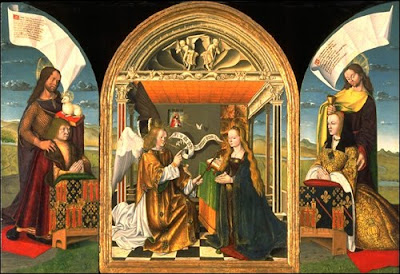
peinture datée de 1497 connue comme le "Triptyque du Maître de Latour d'Auvergne
Jean III de La Tour d'Auvergne est représenté avec son épouse Jeanne (ce sont les grands parents maternels de Catherine de Médicis)
Le tableau qui, au 16ème siècle se trouvait dans la sainte chapelle du château de Vic-le Comte( Puy-de -Dôme) se trouve depuis 1960 aux Etats-Unis au Musée d'Art de Caroline du Nord à Raleigh .
informations très riches(mais en anglais) sur ce tableau à l'adresse suivante
site du musée:/ncartmuseum.org/collections/highlights/european/french/before1760/001_lrg.shtml
pour acceder au tableau:
http://ncartmuseum.org/art/detail/the_annunciation_with_saints_and_donors_called_the_latour_dauvergne_triptyc
http://collection.ncartmuseum.org/collection11/view/objects/asitem/People$004031/0/title-desc?t:state:flow=00ec1dbf-ccaa-4ee9-9918-8bf4033f3890
The subject of this three-panel painting, or triptych, is the angel Gabriel’s Annunciation to the Virgin Mary that she is to be the mother of Christ. His words to her, taken from Luke’s gospel (chapter 1:28), are inscribed in abbreviated Latin on the scroll between them, “Ave gra[tia] plena dominus tecum” (“Hail [Mary], full of grace, the Lord is with you”).
The wings of the triptych, which close like shutters, have preserved the painting in excellent condition. They bear the likenesses of the donors of the work, the count and countess of Latour d’Auvergne. Their names, Jean and Jeanne, are the French masculine and feminine equivalents of the name John and therefore link the subjects with their patron saints. On the left wing, John the Baptist wears a hair shirt, a reminder of his sojourn in the wilderness, and holds a lamb that refers to his pronouncement, “Behold the Lamb of God.” On the right wing, John the Evangelist is identified by his chalice filled with poison (indicated by the dragon), which he was forced to drink, according to legend.
French verses on the banners above the donors offer prayers to the Virgin on their behalf. The verses on the left scroll refer to Gabriel’s annunciation and pray for the salvation of the count. The verses on the right request that the countess be blessed with children. Since the count and countess married in 1495 and are believed to have had their first child in 1498, the inscription dates the painting to about 1497.
The painting is from the beginning of the Renaissance in France. The treatment of the landscape background extending across all three panels reveals the Renaissance interest in portraying biblical events in a natural setting. The hills and vegetation accurately depict both the locality of Auvergne, the province of the count and countess, and the traditional date of the Annunciation, March 25. Other hallmarks of the Renaissance style are the landscape and architecture’s recession into space and the shadows cast by the dove and the angel’s scroll. Some of the architectural details of the columns and capitals show that the artist had some familiarity with Italian Renaissance architecture, perhaps through engravings. Medieval symbols that survived into this period include the Holy Spirit entering the room in the form of a dove, the gilded rays of light emanating from the tiny figure of God in the window, and the white lilies, symbolizing the Virgin’s purity.
- See more at: http://artnc.org/works-of-art/annunciation-saints-and-donors-called-latour-dauvergne-triptych#sthash.SvYe1wws.dpuf
Aucun commentaire:
Enregistrer un commentaire